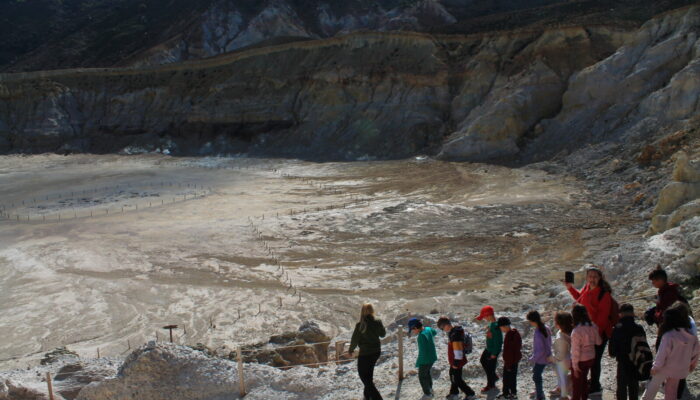
On 20 October 2023, a team of geoscientists will host EGU’s Geoscience Day in Santorini and Nisyros (Greece) with a diverse audience: 60 young students from Nisyros Elementary School, 120 students from the Vocational High School of Santorini, educators, local journalists and representatives of the tourism industry. With such a mixed group of attendees, one might expect unique challenges that come with planning such an event, and with communicating science in a manner that is comprehended by all.
I spoke to Paraskevi (Evi) Nomikou, who is Associate Professor at the National & Kapodistrian University of Athens, and the 2023 awardee of EGU’s Geoscience Days Grant. Read on for excerpts from our discussion!
Hi Paraskevi, congratulations on your project being selected for EGU’s Geoscience Day! Could you tell us why you and your team are interested in geoscience outreach?
There is no doubt that our planet can be perceived as a living organism, and the geosciences – with geology as its primary component – provides insight into many natural phenomena that, in the past, out of fear and ignorance, have been personified as gods. Despite the progress of geology, many problems have still remained unsolved, causing feelings of awe even today. My team and I decided to get involved in geoscience outreach because we deeply believe that our research should not stay exclusively within the narrow framework of our own scientific community but should be communicated to other scientific communities as well as to society. This includes school children, policymakers, journalists and non-governmental organizations. These interactions, we believe, will yield both basic knowledge for non-experts and, potentially, new ideas and different perspectives for us.
Which factors led you to choose Mandraki (Nisyros) and Fira (Santorini) as the locations to host this year’s Geoscience Day?
Along with other Greek volcanic sites, Santorini and Nisyros serve as crucial natural laboratories for enhancing our knowledge of geological processes, volcanic events, and their broader effects on Earth’s systems. These investigations have implications in geoheritage, geothermal energy exploration, disaster preparedness, and the assessment of volcanic hazards while also adding to scientific understanding.
In addition, we choose Mandraki (Nisyros) and Fira (Santorini) as the locations to host this year’s Geoscience Day because the infrastructure needed for such an important event already exists. Nisyros, an aspiring UNESCO Global Geopark (aUGGp), is a fully volcanic island located at the eastern border of the Hellenic Volcanic Arc (South Aegean Sea) with a relatively young age (about 0.2 m.y. B.P.). It hosts spectacular geological formations that clearly depict the stages of the volcano’s evolution, as well as breathtaking geomorphological landmarks such as the iconic caldera, domes and a spectacular active hydrothermal system that has endowed Nisyros with a number of hot springs along its coastline, hot steam emissions, fumaroles and of course hydrothermal craters.
Santorini’s characteristic morphology is the result of one of the most destructive eruptions: the emblematic Minoan eruption that occurred approximately 3600 years ago, with significant cultural effects. The island is well known for its breathtaking scenery, charming towns, and historical significance. Due to its history of intense eruptions, the volcano on Santorini has been the focus of extensive research. Τhe Santorini caldera was recently designated as one of the first 100 IUGS Geological Heritage Sites due to its outstanding global scientific importance. To us, both volcanoes constitute perfect candidates to host the EGU Geoscience Day event.
It sounds fascinating to be able to explore volcanic domes and hydrothermal craters, and to discover the geological histories of these regions. What kinds of activities do you have planned to encourage both classroom and real-world learning?
Our activities will include educational morning lectures and hands-on workshops (physical and digital tours to explore the most significant points of interest of the islands) at Nea Kameni (Santorini) and the Lakki hydrothermal craters (Nisyros), dedicated to the rich geological history of volcanoes and geohazards. Supporting virtual guides that will be used, such as Santorini and Nisyros Volcano apps, provide up to date, simplified scientific material (2D and 3D maps, 360° panoramas and drone footages) that highlight the geodiversity of the onshore and offshore environment. Participants will have the opportunity to experience a virtual tour of the underwater volcanic morphology and also become aware of innovative practices for engaging STEM teaching methods.
Could you share with us some of your experiences and learnings while organizing Geoscience Day?
Of course. Some of my experiences include: realizing the significance of promoting the science behind the geoheritage of volcanoes; raising awareness about potential risks related to volcanic areas; focusing on a cooperative outcome that combines historical and cultural facts with physiographic features; and the joy of trying to think like a child and find answers that meet our participants curiosity about Mother Nature.
I can try to sum up my learnings as follows: discovering new ways to communicate scientific findings to a non-scientific audience; widening the range of our skills to simplify the science and be more comprehensive, designing and organizing an educational event that satisfies the needs of diverse attendees (school children, policymakers, tourist agencies); and being more flexible in adjusting our scientific communication under a wide range of circumstances.
And finally, do you have any advice for others looking to engage in geoscience outreach?
Good geosciences outreach requires a constantly updated background in the geosciences, effective communication strategies and personality skills to convey complex information and connect with diverse audiences. So apart from the obvious qualifications (degrees and knowledge) I would suggest cultivating additional skills. The motivation to study and share new knowledge with others is driven by a natural curiosity about the Earth and its operations. Genuine enthusiasm for geosciences may also magnetize and captivate the interest and attention of others. Finding novel ways to communicate information, using visuals, analogies or story telling, improves learning and engagement. And last but not the least, always keep in mind that accurate, accessible, and ethical communication of scientific information upholds credibility and fosters audience confidence.
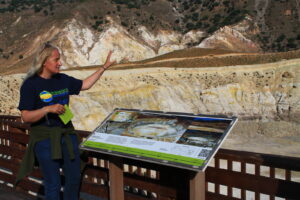
Evi explains the importance of Nisyros Geopark to students,
describing the creation of Nisyros hydrothermal crater
Paraskevi (Evi) Nomikou is a Marine Geologist and Associate Professor of Physical Geography and Geological Oceanography at the Faculty of Geology and Geo-Environment at the National and Kapodistrian University of Athens. She was born in Santorini and during the last two decades, she has been intensively focused on studying the volcanology of Santorini and Nisyros both onshore and offshore. In the last few years, rapid development in the field of virtual reality piqued her interest and she is actively involved in many projects that raise public awareness in this area.
We thank Paraskevi for taking the time to share these insights with us. If you find yourself curious about or interested in geoscience outreach, visit our Outreach page on the EGU website or get in touch via outreach@egu.eu

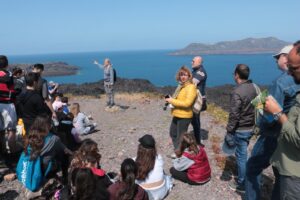
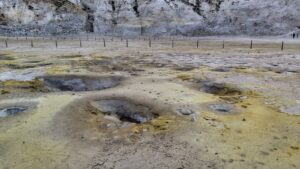
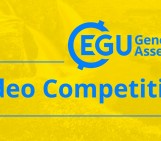
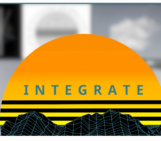
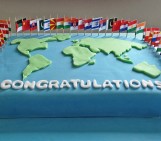
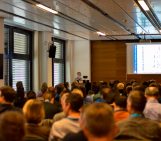
Michael Stellas
All my relatives are from Nikia. My mother told me stories about Nisyros from a young boy. I have been there several times. Especially Avalki. I’ve been a practicing geologist across the globe for 47 years. Maybe my roots are why I have a passion for geology. I’m deeply interested in the geologic and cultural history of my origin.